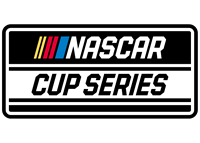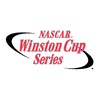NASCAR - NASCAR Cup Series
 |
The NASCAR Cup Series is a stock car racing series owned and operated by NASCAR (the National Association of Stock Car Auto Racing). NASCAR’s premier series had been known as the NASCAR Monster Energy Cup Series since Jan. 1, 2017, rebranded in 2020. It holds races over the season at tracks located in the United States both road courses and ovals. Although the roots of the series was in the use of "stock" manufacturers vehicles, todays cars are custom built automobiles powered by custom built V8 engines.
NASCAR Cup Series Main Page |
NASCAR Cup Series History
NASCAR Monster Energy Cup Series
With the formation of NASCAR (National Association for Stock Car Auto Racing) in 1949 the stock car racing series was known as the Grand National Series. In 1972.the R. J. Reynolds Tobacco Company became the first sponsor of the NASCAR top series.  The Grand National Series name was changed to be the Winston Cup Series. In 2004 R.J. Reynolds was replaced by NEXTEL as the primary sponsor.
The Grand National Series name was changed to be the Winston Cup Series. In 2004 R.J. Reynolds was replaced by NEXTEL as the primary sponsor. At the same time a new points system was implimented, called "The Chase for the NEXTEL Cup ". This format reset the point standings with ten races to go, making only drivers in the top ten or within 400 points of the leader eligible to win the championship.
At the same time a new points system was implimented, called "The Chase for the NEXTEL Cup ". This format reset the point standings with ten races to go, making only drivers in the top ten or within 400 points of the leader eligible to win the championship.
In 2007, NASCAR announced it was expanding "The Chase" from ten to twelve drivers, eliminating the 400-point cutoff, and giving a ten-point bonus for a win in the first 26 races. A merger in 2008 between NEXTEL and Sprint resulted in the series name change to the Sprint Cip. In 2011, a simplified points system was implimented with a winner of a race now receiving 43 points, with one-point increments for each subsequent position (42 for second, 41 for third, and so on). The winner also receives 3 bonus points, and single bonus points are awarded to all drivers who lead a lap plus the driver who leads the most laps. Another significant change involved the qualifying process for the Chase. The number of qualifying drivers will remain at 12, but only the top 10 will qualify based on regular-season points. The remaining two Chase drivers will be the two drivers in the next 10 of the point standings (11th through 20th) with the most race wins in the regular season.
For  the 2013 season qualifying for the Chase was revised again to reward race winners. The Chase field was expanded from 12 to 16 and the first 15 spots are reserved for the drivers with the most race wins over the first 26 races.
the 2013 season qualifying for the Chase was revised again to reward race winners. The Chase field was expanded from 12 to 16 and the first 15 spots are reserved for the drivers with the most race wins over the first 26 races.
The Chase is now divided into four rounds. After each of the first three rounds, the four Chase drivers with the fewest season points are eliminated from the Chase and championship contention. Any driver in the Chase who wins a race in the first three rounds automatically advances to the next round. Also, all drivers eliminated from the Chase have their points readjusted to the regular-season points scheme. The Challenger Round (races 27-29) starts with 16 eligible drivers, each with 2,000 points plus a 3-point bonus for each win in the first 26 races. The Contender Round (races 30-32) begins with 12 eligible drivers, each with 3,000 points. The .Eliminator Round (races 33-35) starts with eight eligible drivers, each with 4,000 points. The final race pits rthe final four eligible drivers against each other in a winner take all contest. The last four eligible drivers for the season title start the race at 5,000 points, with the highest finisher in the race winning the Cup Series title. 
For the 2017 season Monster Energy took over as the sponsor from Sprint for the Cup Series.. In addition there were numerous changes to the both the racing and Chase formats. These changes including breaking a race into segments with the first ten finishers in each segment being awarded chanpionship points. Normal points will be awarded to the finishing order of the race (40 points to first, 39 to second, 38 to third, etc.).
 In 2020 NASCAR renamed the Cup series to the NASCAR Cup Series.featuring four cornerstone brands as Premier Partners namely Busch Beer, Coca-Cola®, GEICO and Xfinity. All four partners are prominently featured in multiple platforms across the sport, including integrations in broadcast, NASCAR digital and social channels, event entitlements, in-market promotions and at-track activations.
In 2020 NASCAR renamed the Cup series to the NASCAR Cup Series.featuring four cornerstone brands as Premier Partners namely Busch Beer, Coca-Cola®, GEICO and Xfinity. All four partners are prominently featured in multiple platforms across the sport, including integrations in broadcast, NASCAR digital and social channels, event entitlements, in-market promotions and at-track activations.
 Rauzulu's Street
Rauzulu's Street Racing Section
Racing Section